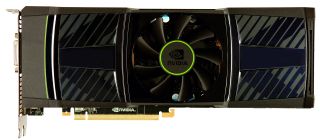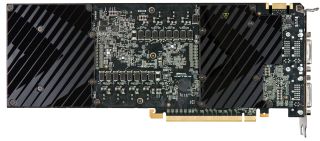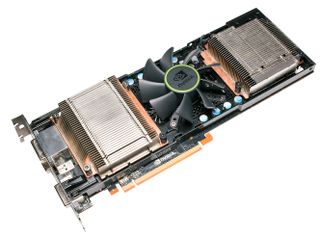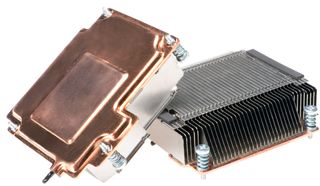Nvidia GeForce GTX 590 3 GB Review: Firing Back With 1024 CUDA Cores
AMD shot for—and successfully achieved—the coveted “fastest graphics card in the world” title with its Radeon HD 6990. Now, Nvidia is gunning for that freshly-claimed honor with a dual-GF110-powered board that speaks softly and carries a big stick.
Building A Dual-GPU Beast...And Keeping It Classy?
The Radeon HD 6990 4 GB is a card that makes no apologies. It’s big. It’s fast. It’s hot. It’s expensive. It’s loud. Some of the comments on my review of that board tried to draw parallels between the 6990 and Bugatti’s Veyron supercar. That’s way too complimentary. It’s really more of a Viper. The Viper is still sexy, but it’s nowhere near as masterfully crafted as a Bugatti, and AMD’s flagship doesn’t hesitate to get up in your face as it delivers its performance. Nvidia claims it was going more for Porsche-like nimbleness. Again, that’s hardly seems plausible given what we know sits under the GeForce GTX 590’s hood. But I didn’t jump to conclusions about AMD’s card until I had the data, and I won’t do that here, either.
Long, Strong, Something About Friction…
Nvidia’s card is big as well. Whereas the GeForce GTX 580 measures 10.5” long, the 590 is 11” long. But that’s a full inch shorter than AMD’s 12” Radeon HD 6990 (and indeed the 5970, which was also a 12” board).


Similar to the 6990, Nvidia employs a mid-mounted fan design. The company says this was necessary—the blower-style fan responsible for cooling the GeForce GTX 580 would have generated far too much noise as it tried to dissipate the board’s rated 365 W. Be that as it may, I didn’t like the challenges of pumping gratuitous heat into my chassis with AMD’s design, and it doesn’t get any more attractive coming from Nvidia. The difference is that, while AMD employed a mid-mounted fan and failed to strike a balance on the acoustic side, Nvidia gives us a more useable experience.

Perhaps surprisingly, the company doesn’t deviate too far from the game plan AMD executed. Its GF110 GPUs sit on either side of the center-mounted fan. Vapor chamber-based heatsinks cover each graphics processor, and an array of aluminum fins on each of them directs air out the front and back. But AMD uses a centrifugal fan. Nvidia employs an axial fan. And that distinction apparently makes the difference in noise output. Nvidia also claims that its vapor chamber design is superior, but without any way to quantify those claims or the benefit of AMD’s phase-change thermal interface material that supposedly helps improve thermal performance by 8%, we’ll stop short with the fan analysis.

As far as exhaust goes, Nvidia is actually at a disadvantage. AMD’s elegant use of DisplayPort allows the Radeon HD 6990 to offer five independent outputs, while still leaving an entire expansion slot for pushing heat out of the card’s shroud. Nvidia exposes three dual-link DVI outputs and one mini-DisplayPort connector—arguably a more klugey way to enable fewer outputs, but justifiable when you consider each GF110 is limited to two outputs anyway. Between those four ports, the 590 is left with little more than half of one slot for exhaust.
It’s also worth noting that Nvidia’s fan speed ramp is more granular than AMD’s. During testing, I found that the Radeon HD 6990 spins at 2180, 2880, or 3600 RPM. Stepping between those speeds is very obvious. The 590 adjusts more dynamically, and you really don’t notice when it accelerates. At the risk of giving too much away on page two, the result is one decibel more than the already-quiet GeForce GTX 580 under maximum load.
Stay on the Cutting Edge
Join the experts who read Tom's Hardware for the inside track on enthusiast PC tech news — and have for over 25 years. We'll send breaking news and in-depth reviews of CPUs, GPUs, AI, maker hardware and more straight to your inbox.

More Power Means More Heat
Nvidia’s exceptional acoustic performance is all the more spectacular when you consider its power requirements. According to the company, the GeForce GTX 590 has a 365 W thermal limit. That would seemingly compare favorably to AMD’s Radeon HD 6990, rated at 375 W at its stock 830 MHz and 450 W overclocked (and overvolted) using the built-in firmware selector. The thing is, on average, the GeForce GTX 590 uses more power than the 6990 at that overclocked setting. I mean, the two setups are close (separated by 5 W), but the 590 is still the highest-power offering, despite Nvidia’s rating.
Driving such a power-hungry card naturally means using two eight-pin PCI Express power connectors, and Nvidia recommends at least a 700 W PSU to get the job done.
Current page: Building A Dual-GPU Beast...And Keeping It Classy?
Prev Page GeForce GTX 590: Bringing The Heat Next Page Display Outputs And Tessellation Performance-
nforce4max Nvidia like ATI should have gone full copper for their coolers instead of using aluminum for the fins. :/Reply -
The_King The clock speeds are a bit of a disappointment as well the high power draw and the performance is not that better than a 6990. Bleh !Reply -
LegendaryFrog I'm impressed, good to see Nvida has started to care about the "livable experience" of their high end products.Reply -
rolli59 Draw! Win some loose some. What is the fastest card? Some will say GTX590 others HD6990 and they are both right.Reply -
Scoregie MMMM... HD 6990.... OR GTX 590... HMMM I'll go with a HD 5770 CF setup because im cheap.Reply -
Sabiancym You can't say Nvidia wins based on the sound level of the cards. That's just flat out favoritism.Reply
I'll be buying a 6990 and water cooling it. Nothing will beat it. -
Darkerson rolli59Draw! Win some loose some. What is the fastest card? Some will say GTX590 others HD6990 and they are both right.Thats more or less how I feel. They both trade blows depending on the game.Reply
Most Popular


